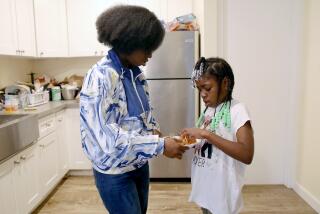Wiping Out Poverty, One Loan at a Time : THE PRICE OF A DREAM: The Story of the Grameen Bank and the Idea That Is Helping the Poor to Change Their Lives by David Bornstein; Simon & Schuster $25, 370 pages
- Share via
Thirty years ago in Venezuela, I met a representative of ACCION International, a private American organization devoted to promoting development among the poor by lending them money to start small businesses. For less than $100, a poor woman could buy a sewing machine with which to support herself by making shirts.
It was a novel idea at the time. The prevailing theory was that Third World countries would be pulled out of poverty by massive industrial developments financed by governments and the World Bank.
If there was small-scale development, it was done chiefly by churches and the then-new U.S. Peace Corps. In a world where the New Deal was a recent memory and socialism a worldwide creed, the idea that the credit mechanism of capitalism could be harnessed to lift poor people out of poverty was a quaint notion.
Not anymore. Micro-credit is a worldwide phenomenon. ACCION lent out $330 million to small-business entrepreneurs last year and has established programs in six American cities. The best-known micro-credit operation is the Grameen bank of Bangladesh.
This is the story that David Bornstein, a Canadian journalist living in New York, conscientiously tells in this carefully researched book.
The bank’s charismatic founder, Muhammad Yunus, worked by trial and error to construct an institution based on the realities of village life.
Grameen comes from the Bangladeshi word “gram,” which means village. The Grameen bank lends only to poor villagers, in the hope that by their efforts they will become a little less poor.
In the last two decades the bank, which is supported by international donations, has lent out $1.5 billion for self-employment purposes to poor Bangladeshis. Today the bank has more than 1,000 branch officers and 2 million clients--94% of them women.
Most loans are for only a few hundred dollars. Of them 97% has been repaid. One study of the bank estimated that it had lifted 75% of its borrowers above the Bangladeshi poverty line.
Bornstein brings his subject to life in interviews with bank workers and clients.
Oirashibala Dhor, a Hindu woman in the largely Muslim country who is a peddler of bangles, lip gloss, hairpins and the like, borrows from the bank to buy the things she sells.
She had served as a chief of her group, the small number of workers who, under the bank’s rules, are responsible for following the bank’s 16 “decisions,” or mottoes.
* “The four principles of Grameen Bank--Discipline, Unity, Courage and Hard Work--we shall follow and advance in all walks of our lives.”
* “We shall build and use pit latrines.”
* “We shall educate our children. . . .” How much her loan improved Oirashibala Dhor’s lot in life is a question that goes beyond the scope of the book. For, though one of the bank’s 16 “decisions” condemns dowries, Bangladesh is rife with the practice, and when we last see Oirashibala Dhor she is still paying off a money lender for her first daughter’s wedding a decade earlier, and is trying to save for her next daughter’s dowry.
The question raised here, it seems to me, is whether micro-credit without modernization of ancient village culture is enough to raise poor villagers out of poverty.
Yunus, the charismatic founder of the bank, has no doubts. Bornstein quotes him in a typically bold aphorism:: “Maybe our great-grandchildren will go to museums to see what poverty was.”
More to Read
Sign up for Essential California
The most important California stories and recommendations in your inbox every morning.
You may occasionally receive promotional content from the Los Angeles Times.













